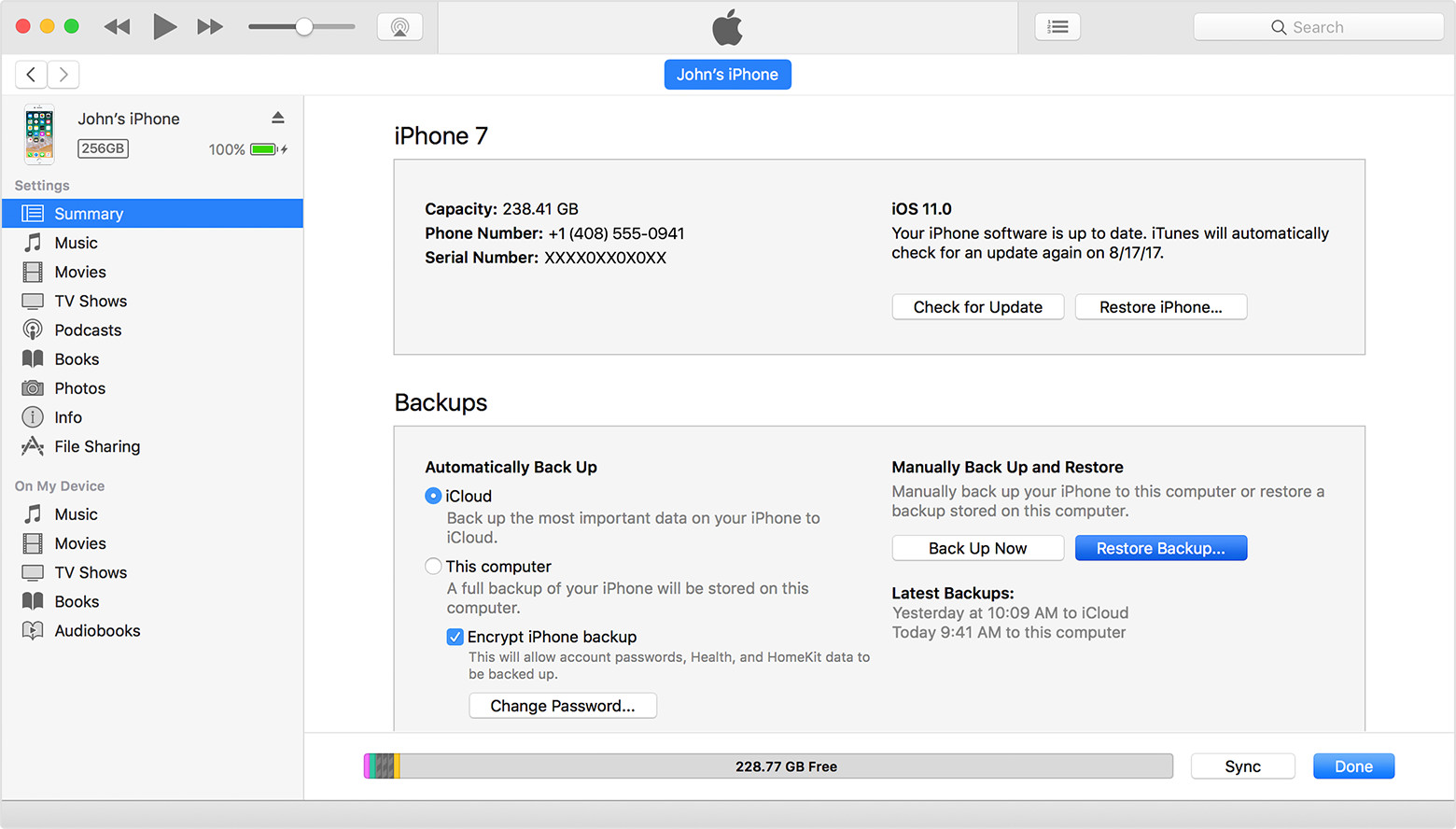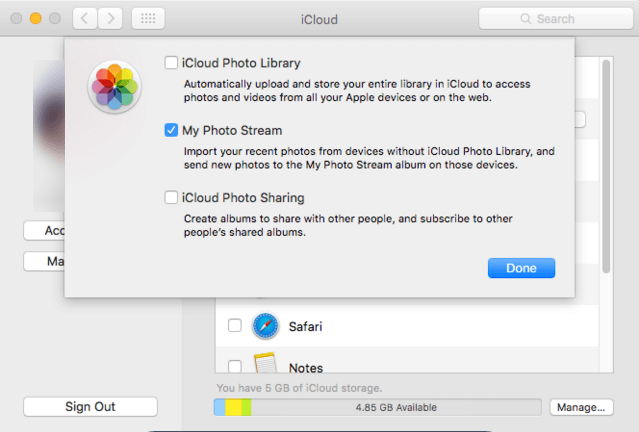Last Updated : | Wide Angle Software
Jun 24, 2014 Make sure the disk is formatted Mac OS Extended (Journaled) Most Simple Back Up: Drag the iPhoto Library from your Pictures Folder to another Disk. This will make a copy on that disk. Slightly more complex: Use an app that will do incremental back ups. This is a very good way to work. What Folders to Choose When Manually Backing Up Your Mac. Another location you may wish to back up is the system level Library folder. Is also prime target for backup. The Mac App Store. When troubleshooting a computer problem sometimes its best to just wipe the hard drive and start fresh. I developed the following method for backing up user home folders so that they can easily be restored to another computer or the same computer while preserving proper permissions, ACLs, and file.
If you backup your iPhone using iTunes, the backup file is stored on your PC or Mac.. but where?
Want to find your iTunes backup location, extract data from a backup, or restore your iPhone from a backup? You're in the right place.

iPhone backup location Windows PC:
Where are iPhone backups stored? On Windows systems, your iPhone backups are located here: Users(username)AppDataRoamingApple ComputerMobileSyncBackup
To locate a list of your backups manually, follow these steps:
- Open your search box.
- Windows 7: click Start
- Windows 8: click the magnifying glass in the top-right corner
- Windows 10: click the Search box next to the Start button
- Click inside the search box and type: %appdata%
- Hit Enter (Return) on your keyboard
- From here, open these folders: Apple Computer > MobileSync > Backup
Your backups will now be listed for you as seen in the image below. Note that these files are not human-readable. If you need to view and access this data, skip to step 3.
You may also like: How to back up your iPhone >
Back up with Time Machine. Time Machine is the built-in backup feature of your Mac. It’s a complete backup solution, but you can use other backup methods as well. (Mac) Connect your Seagate storage device to your computer and you’re ready to back up your important files and folders. The fastest way to back up is to select items on your computer and copy them to your drive by dragging and dropping. Jul 21, 2010 Select “Back Up Now” to begin the instant backup; Time Machine will now begin a full manual backup of your Mac’s hard drive. This can take quite a while depending on how many changes have been made to the Mac and the file system, and thus should be left alone to run a full backup course. Mac Geek Gab listener Jurgen doesn't like Time Machine, and would rather back up his Mac using third party software. Time Machine automatically chooses which files and folders to back up, but. Backup mac software.
An MPD can be effortlessly combined with other MPDs. With excellent tools, even the smallest PD pulses are separated from interference and analyzed. Manual mac md 600 diferen. It is the only system worldwide that records and analyzes the signals of all connected measurement points at the same time.Hundreds of MPD systems are currently in use across the globe. The MPD 600 is suitable for many different PD testing applications.With many complex test objects, e.g. Generators, multiple simultaneous measurements offer a distinct advantage.
iPhone backup location Mac:
Where are iPhone backups stored? On Mac systems, your iPhone backups are located here: ~/Library/Application Support/MobileSync/Backup/
To access this location, click in the menu bar, then type the address above.
-Or-
To find a specific backup, you can use iTunes:
- Open iTunes.
- In the menu bar, click iTunes -> Preferences.
- Click the Devices tab.
- Control-click the backup that you want from the list.
- Click 'Show in Finder'.
Note that these files are not human-readable. If you need to view and access this data, skip to step 3.
Recover data from your iPhone backup
As these backups are designed to keep your data safe, until needed for an iPhone restore, you cannot view and access individual items within the backup - e.g. if you want to copy out a particular photo album to your PC. If you'd like to browse your backups, and extract data from them to your PC, you'll need a third-party software like iBackup Extractor.
Mac Backup To External Hard Drive

If you should need to retrieve data from your iOS device backups, such as contacts, messages, photos and more, iBackup Extractor can do just that!
With iBackup Extractor you can even access and view the contents of iPhone backups on your computer FREE.
Download the free demonstration version of iBackup Extractor today, to see what you can extract from your backups to your computer.
Free iBackup Extractor Download for PCFree iBackup Extractor Download for MacRestore iPhone from backup
There are many reasons that you'd need to restore an iPhone from a backup: Troubleshooting problems on your iPhone, data loss, and a broken/damaged device to name a few.
Here's how to restore an iPhone backup from your computer..
- Open iTunes on the PC or Mac that you backed up your iPhone to.
- Connect your iPhone with your USB cable.
- Select your device icon in iTunes.
- Click 'Restore Backup..'
- Pick the backup you'd like to restore, and click 'Restore'.
If you run into any issues when attempting to restore a backup to your iPhone, Apple's iTunes guides are great!
You may also like: How to delete backups from your computer >
Any questions? Contact our friendly support staff at
ATLAS.ti 8 Mac Rewritten from the ground up, Mac users are able to run ATLAS.ti natively, bringing you the power and flexibility of our leading QDA software. Atlas ti software. See full manual for instructions on how to use the auto coding tool. ATLAS.ti 8 Mac - Quick Tour. MAIN CONCEPTS AND FEATURES 6 The length of a code should be restricted and should not be too verbose. If textual annotations are what you want, you should use quotation comments instead. GENERAL PROCEDURE 4 General Procedure In this document we describe how you set up a team project when using ATLAS.ti Mac. If your team uses ATLAS.ti 8 Windows, or you work in a mixed Windows-Mac team, please check our website for the. ATLAS.ti for Mac – Admin Documentation. Team Work with ATLAS.ti Mac. Team Work with ATLAS.ti Mac and ATLAS.ti 8 Windows (mixed teams) Inter-Coder Agreement Analysis with ATLAS.ti 8 Mac. Importing and Exporting Code Lists: ATLAS.ti 8 Mac. Backing up ATLAS.ti Mac Projects.
View and Download Apple Mac Pro user manual online. Apple Computer User's Guide Mac Pro computer. Mac Pro Desktop pdf manual download. Also for: Mac pro (8-core. Mac pro a1186 manual. Learn how to set up and use your Mac Pro. Find all the topics, resources, and contact options you need for your Mac Pro. Open Menu Close Menu. If you can't get your printer to work with your Mac, iPhone, iPad, or iPod touch, these steps might help. Manual downloads. Have a question? Ask everyone. Load more results. Apple Footer Apple Support. Apple Mac Pro 'Quad Core' 2.66 (Original) Specs. Identifiers: Mac Pro - MA356LL/A - MacPro1,1. A1186 - 2113 All Mac Pro Models All 2006 Models Dynamically Compare This Mac to Others. Distribute This Page: Bookmark & Share Download: PDF Manual The first Intel-based tower Mac, the Mac Pro 'Quad Core' 2.66 is powered by two 2.66 GHz dual core Intel Xeon 5150 processors with 4 MB of.
Back to iBackup Extractor SupportAt some point in time during the life of any Mac (or Windows PC) user, we are faced with one of these scenarios:
- Running out of space in our hard drives.
- Adding a second hard drive to our Macs.
- Changing Macs altogether.
- Wanting to backup all our important media.
For any of these, changing the location of your iTunes media can be a great solution, allowing you to have a copy of all of it for either backup purposes or simply for storing it somewhere else until you are ready to place it back on your new hard drive or Mac.
However, contrary to other apps, iTunes is a self contained application, much like others that Apple offers by default on Macs. Some examples of these are iPhoto, Numbers, Pages and more, all of which make users manage their files (music and other media in the case of iTunes) directly from within the app instead of from external folders.
This makes finding and messing around with those files and folders a far more delicate endeavor than if they were located on just on any regular folder. In fact, if you are not careful when doing so, removing or meddling with the wrong file can completely break your iTunes library and render it unusable.
Because of this, here I’ll show you two different methods to move your iTunes Media folder: The Apple method and the non-Apple method.
Let’s get going.
Disc was formatted totally? How to fix corrupted photos on Mac? Mac manual update corrupt image.
The Apple Method
Step 1: Open iTunes and from the menu bar go to Preferences. Once the Preferences panel is open, click on the Advanced tab.
Step 2: Make sure to check the Keep iTunes Media folder organized checkbox. Then, click on the Change button to select the new location of your iTunes Media folder.
Step 3: Once you choose a new location for your iTunes Media folder, from the menu bar look for the Library option under File. There, select Organize Library.
Step 4: On the window that pops up, check the Consolidate Files option. This option will place all your iTunes Media files inside the new iTunes Media folder leaving the original ones untouched. Even better, the new folder will have every score and play count of your original iTunes library.
Step 5: Now that your new iTunes Media folder is ready, you can delete the old one from its original location. To find it, open a Finder window, click on Music, open the iTunes folder and delete ONLY the iTunes Media as shown in the screenshot below.
Mac Backup Time Machine
The Non-Apple Method
While the method shown above is the one recommended by Apple, there is a far simpler one, although it involves moving your entire iTunes folder.
Step 1: Close iTunes and then open a Finder window. There, go to the Music folder and there you will find the iTunes folder. Drag that ENTIRE folder to its new location and you are done.
Step 2: Open iTunes while pressing the Alt key on your keyboard. A dialog box will pop up prompting you to choose the location of the new iTunes library. Locate the new iTunes folder and select the iTunes Library.itl file within.
You are done! Now you know how to backup or relocate all your iTunes media without a hassle. Enjoy!
Manual Mac Backup Library Folder Windows 7
Also See#backup #itunesDid You Know
Till 2017, Google had registered more than 2 billion monthly active devices on Android.